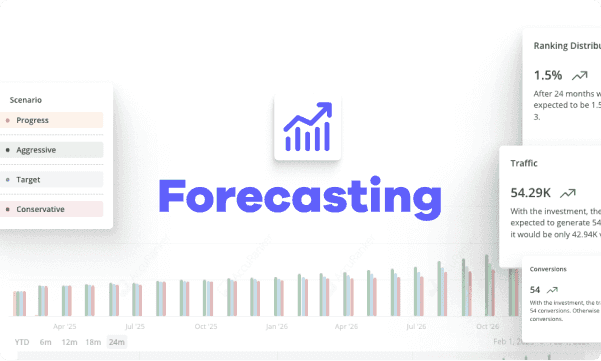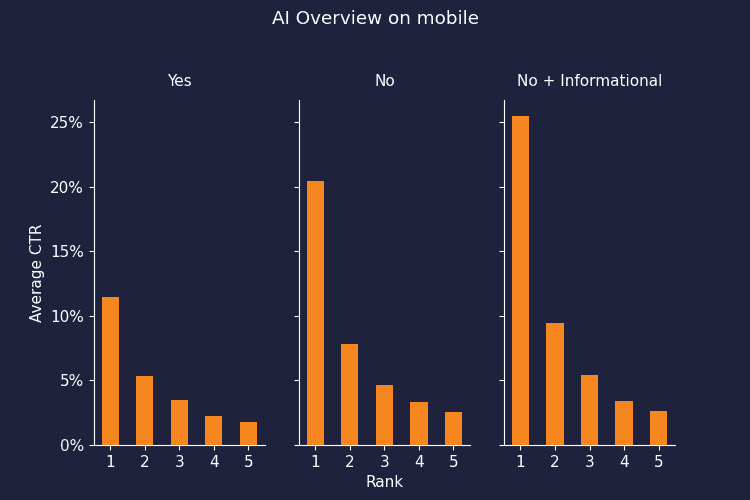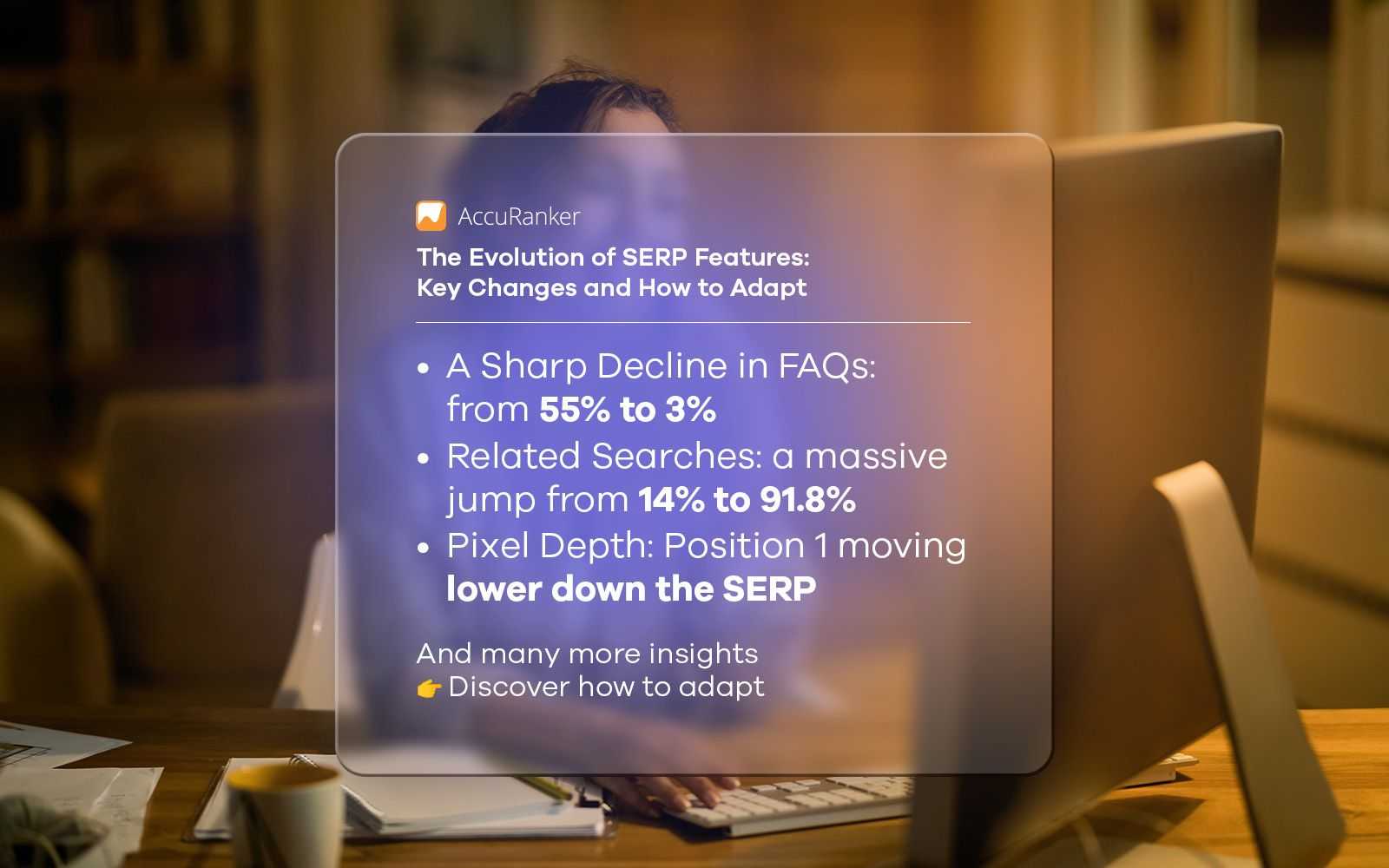What is search intent?
Last updated on Wednesday, September 21, 2022
Introduction
Search intent or user intent is a formalization of the underlying reason the user makes a given search. When searching on Google, the user may look for a specific website, information, products, or something else.
When discussing search intent, it is important to understand the distinction between the actual intent and what intent(s) Google is catering to. The AccuRanker search intent model is designed to determine what intent Google is catering to.
In most cases, Google has a fairly good idea of the user’s intent and has designed the SERP to match this. In some cases, the intent is ambiguous, and Google will show content catering to different search intents. There may also be cases where you disagree with the intent Google is catering to for a given search, and you may even claim that Google is not detecting the actual intent properly.
And you may be right, even Google makes mistakes. Nevertheless, you will not rank on a keyword if your content does not match the intent Google is trying to cater to. Therefore, the AccuRanker search intent model provides predictions of the intent(s) catered to by Google as indicated by the SERP.
In this article, we provide examples and rules of thumb for different intents. But it is impossible to lay out a definitive set of rules on how to distinguish the different search intent categories. However, harnessing the power of AI (artificial intelligence), we have created a search intent classification model more accurate than you have ever seen before.
Search Intent Categories
We group search intent into four categories: Transactional, commercial, navigational, and informational. These categories are standard in the industry, but the finer nuances of the definitions and which SERPs match what categories are not completely set in stone.
There is a certain overlap between the categories, and many keywords have multiple intents. We will get back to this later in this article. In this section, we outline the four categories with examples and common traits of the SERP for these intents.
Transactional intent
The searcher wants to buy something or perform some action. In many cases, they know what they want to buy. They may not know the exact product they are looking for, but as a minimum have a product category in mind and are ready to buy something without further investigation.
What characterizes the SERP for transactional intent?
For searches where Google believes the intent is transactional, there will often be Google Shopping. Titles and descriptions on the SERP often contain transactional words like sale, discount, buy, shop, etc. The keyword itself may also contain these words. The URLs on the page often contain /shop/ or /products/, and there will often be many product pictures.
In countries where Amazon has a webshop, the presence of Amazon on the SERP is also a good indicator.
Typical transactional searches are product names, some even combined with a transactional word. However, not all product names correspond to transactional searches. For more expensive items or items where you primarily make in-person purchases (such as cars), you will often get content satisfying either commercial or informational intent. This also goes for many online services, for example, rank trackers.
This makes complete sense, as such purchases are seldom conducted without proper research. Hence you are often not in “buying mode” when making such searches. See also the example found in the section multiple intents. On the other hand, if you search for a more “easy to buy” product like Nike Air Jordan, you will see content catering to a transactional intent.
Examples of transactional searches:
- Buy Sonos One
- Nike Vaporfly
- Cheap iPhone
Guessing the intent from the keyword alone is not an easy endeavor, but the SERP tells a story of its own. Consider, for instance, the keyword 3070. This has transactional intent. If you did not know that Nvidia makes a graphics card with this number, you could not have guessed it. This keyword may even have split intent depending on the location where the search is made, as it also corresponds to a postal code in Denmark and Australia!

Many transactional keywords have split intent, and Google may show content on the SERP satisfying several intents. The most common intent you will see alongside transactional intent is commercial intent. But it is also possible to see combinations with navigational and/or informational intent.
Commercial intent
The searcher is looking for a product/service but has yet to decide which product/service is right for them. They may be looking for reviews and comparisons or results nearby. They’re still weighing up their options.
What characterizes the SERP for commercial intent?
Words like review, comparison, best, and top are common in the keyword, in the titles, and in the descriptions on the SERP. There are often local results. Competition on AdWords is also an indicator, and there may be SERP features like popular products and research product.
There is a fine line between commercial and transactional searches. AccuRanker distinguishes these two categories by looking at the content Google is serving. Consider, for instance, the keyword crayons. Is the customer still in a research phase? Or is the customer ready to buy something? The SERP gives the answer:

You will see that most results are links to product pages where you can buy crayons. Google believes this keyword has transactional intent. On the other hand, the keyword best crayons gives results indicating commercial intent. As a rule of thumb: if there are many links directly to pages where you can buy an item, it is transactional. If there are many comparisons and reviews, then it is commercial.
Examples of commercial searches:
- Best wireless speakers
- Sonos one review
- Food near me
- Attorneys New York
Many local searches have commercial intent. You may have been in this situation before yourself, where you need a product/service. For instance, a carpenter nearby. You want to hire a carpenter, but you need to weigh up your options first.
Navigational intent
The searcher is looking for a specific website or a specific place. The searcher already knows where he/she wants to go but may not know the exact URL. Or maybe too lazy to type it out, or they are looking for directions if it is a physical place.
It is important to know that ranking for navigational searches yields a low CTR unless your website is the target for the navigational search. Thus, you should generally not spend your energy trying to rank for navigational searches.
What characterizes the SERP for navigational intent?
For SERPs with navigational intent, you will often see sitelinks, either multiple or single. Another common feature is knowledge panels. But be aware that these are also often present in informational searches! Local results are also relatively common.
Furthermore, you will often see Facebook, LinkedIn, and/or Twitter in the top ten results as many businesses will have an account/page here which will show up. Navigational searches typically (but not always) have low competition on AdWords. Navigational intent is not commonly mixed with others but can be. For instance, the SERP for the keyword Adidas has traits of both navigational, informational, and transactional intent.

Examples of navigational searches:
- AccuRanker
- AccuRanker organic site explorer
- Gmail login
- Tivoli Copenhagen
Informational intent
The searcher is looking for information. This is a broad category of searches and, for this reason, also the most common search intent. It could be a keyword like weather or SEO. It could be a question like what is search intent which, as you would know by now, is not something with a short and simple answer. Or it could be a simple question like how old is Joe Biden where Google will show the answer directly on the SERP in a knowledge card.
What characterizes the SERP for informational intent?
SERPs with informational intent often have knowledge panels or knowledge cards. Related questions are often near the top, and you will also often see videos. For pure informational searches, the keyword or the titles and descriptions may contain phrases like how, what, where, who, tutorial, example, guide, news, etc.
In many cases, Wikipedia will be one of the top ranks, there may be recipes, direct answers, or news on the SERP. Informational intent is also often mixed with other intents. For instance, there is a fine line between looking for information to research a product (commercial) or looking for more general information.

Examples of informational searches:
- Tour de France 2022 route
- How to tie a tie
- What is search intent
- Weather
Multiple Intents
It is far from uncommon that a search can have multiple intents. Consider, for instance, the search Tesla Model X. Below you can see a SERP corresponding to a search made from Desktop in London, UK. (Try for yourself with AccuRanker’s free SERP checker).

To the right on the SERP, you see a knowledge panel, we have a people also ask section, and rank 2 is Wikipedia. All indicative that this is an informational search. But scrolling further down, you will also see reviews and prices indicating Commercial intent. You may even argue that this could also have navigational intent, which is often associated with site links as many people would be looking to visit the Model X page on tesla.com.
Can Search Intent Change Over Time?
It is important to understand that search intent is not static. Remember that when talking about search intent, we are always referring to the intent catered to by Google. There are several reasons the intent may change over time. Some of them could be:
- The “underlying” intent behind a keyword may change over time. The intent could be seasonal or tied to specific events. For instance, Ed Sheeran concert Copenhagen may be transactional before the concert is held (looking to buy tickets) and informational afterwards (looking for reviews or recordings). Searches related to Ukraine may, for instance, also have changed intent since the war started. Here, Google is updating results due to external factors.
- Google starts showing different content due to an algorithm update intended to provide a better user experience.
- Google is unsure of the intent and changes the content based on user behavior.
AccuRanker’s machine learning model is looking for changes in the SERP, and if the SERP changes enough, the search intent may also change. A change in search intent may be a good clue to start creating new or updated content for a specific keyword.

Article by:
Bo Ekkelund
Chief Marketing Officer at AccuRanker
As the Chief Marketing Officer at AccuRanker, Bo is responsible for all aspects of AccuRanker’s marketing - including outlining and implementing the company’s worldwide marketing strategy and branding. A marketing senior with more than 20 years of software marketing experience, Bo has both firsthand and strategic experience with all major marketing tactics and technologies.


